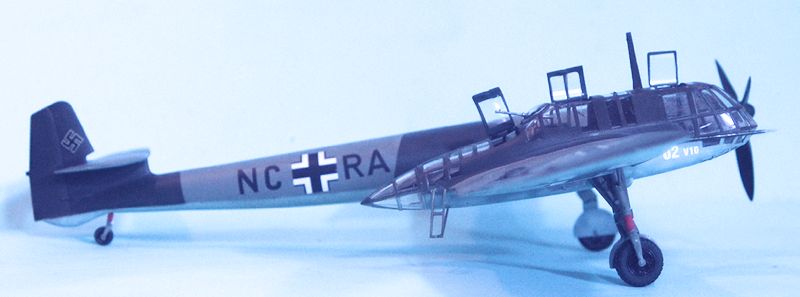
Hobby Boss 1/48 Bv-141B
| KIT #: | 81728 |
| PRICE: | 6,000 yen at HLJ |
| DECALS: | Two options |
| REVIEWER: | Tom Cleaver |
| NOTES: | New tool kit |

| HISTORY |
The aircraft was
the result of a 1937 specification issued by the
the Reichsluftfahrtministerium (RLM) for a single-engine
reconnaissance aircraft with optimal visibility for the crew. The preferred
design was the Arado Ar 198; however, the prototype proved unsuccessful. The
eventual winner was the
 Focke-Wulf
Fw 189 Uhu, even though it had a twin engine design, rather than the desired
single engine.
Focke-Wulf
Fw 189 Uhu, even though it had a twin engine design, rather than the desired
single engine.
Blohm & Voss,
although not invited to participate, pursued a private venture far more radical,
designed by Dr. Richard Vogt, the asymmetric BV 141.
| THE KIT |
 Airfix first released a
1/72 kit of the Bv-141B in the late 1960s.
In around 1995, a 1/48 kit was released by HiPM.
The kit is very difficult, with things not helped by the
fact that the clear plastic crew pod is split vertically, which wrecks many of
the upper clear sections.
While some of these were eventually built by committed
modelers, the majority of modelers who attempted this kit were eventually
defeated (including yours truly).
Airfix first released a
1/72 kit of the Bv-141B in the late 1960s.
In around 1995, a 1/48 kit was released by HiPM.
The kit is very difficult, with things not helped by the
fact that the clear plastic crew pod is split vertically, which wrecks many of
the upper clear sections.
While some of these were eventually built by committed
modelers, the majority of modelers who attempted this kit were eventually
defeated (including yours truly).
This new kit by Hobby Boss, which takes advantage of new developments in molding technology, solves all the problems of the HiPM kit, though it strangely manages to have a prop with the blades reversed. There is now a resin replacement available from Aires, and a rumor that Hobby Boss has changed the prop for future releases. Decals are provided for the first two Bv-141B prototypes.
| CONSTRUCTION |
 The kit is
well-designed and will present no problems for an OOB build following the
excellent instructions.
I first painted all the interior for the crew pod with Xtracrylix
RLM 66 Schwartzgrau.
I also painted the interior side walls of the clear
upper section of the pod.
While all that set up, I assembled the wing and
fuselage, all of which went together without need of filler anywhere.
The kit is
well-designed and will present no problems for an OOB build following the
excellent instructions.
I first painted all the interior for the crew pod with Xtracrylix
RLM 66 Schwartzgrau.
I also painted the interior side walls of the clear
upper section of the pod.
While all that set up, I assembled the wing and
fuselage, all of which went together without need of filler anywhere.
| COLORS & MARKINGS |

I painted the
lower surfaces with Xtracrylix RLM 65 Hellblau, and the upper surfaces with RLM
02 Graugrun and RLM 71 Dunklegrun.
Once dry, a coat of Future was applied.
The kit decals
went on without problem.
I then applied two coats of Micro-Scale clear flat.
I have been using this lately for the first time in more
than 30 years, due to the unavailability of any other acrylic flat, and find
that cutting it 50-50 with tap water gives a very nice flat finish with a slight
sheen, which is actually the way a flat finish looks out of the factory.
| FINAL CONSTRUCTION |
 I unmasked the pod, then assembled and attached the
landing gear.
Since the model is headed for the Planes of Fame Museum, where
the likely audience will not note the incorrect prop, I used that.
If you have a Fw-190D-9 prop in the spares box, this
will work, or you can order the Aries resin replacement.
Other modelers have noted that the extra prop in the
Eduard Fw-190A-8 kit (which is unused) is correct for this airplane.
I unmasked the pod, then assembled and attached the
landing gear.
Since the model is headed for the Planes of Fame Museum, where
the likely audience will not note the incorrect prop, I used that.
If you have a Fw-190D-9 prop in the spares box, this
will work, or you can order the Aries resin replacement.
Other modelers have noted that the extra prop in the
Eduard Fw-190A-8 kit (which is unused) is correct for this airplane.
| CONCLUSIONS |
She Who Must Be
Obeyed took one look at the model and shook her head in wonder.
I think no one who has ever seen a Bv-141 had had a
different first reaction.
Those who enjoy odd-ball airplanes will like this kit,
which is well-designed and produced and presents no problems in building a very
nice model.
Highly recommended.
November 2014
Review kit courtesy of
HobbyLink Japan.
If you would like your product reviewed fairly and fairly quickly, please contact the editor or see other details in the Note to Contributors.